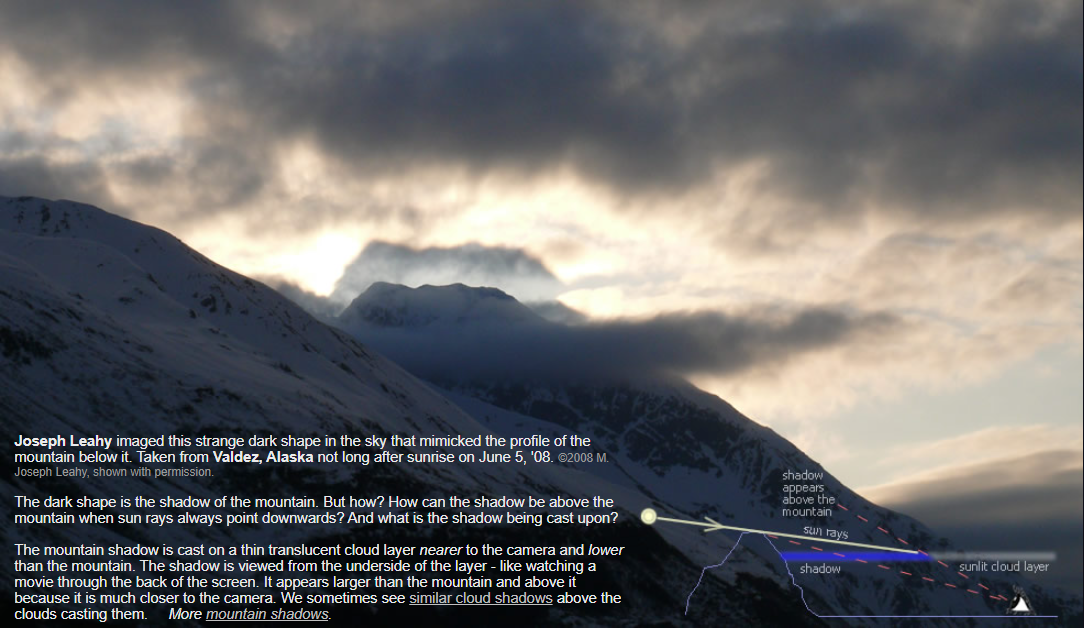Alaskan Mystery Shadow
Alaskan Mystery Shadow: Unveiling the Enigma
Have you ever come across a photograph that left you bewildered, questioning the laws of physics and the nature of shadows? One such captivating image is the "Alaskan Mystery Shadow" captured by M. Joseph Leahy in Valdez, Alaska. This photograph showcases a peculiar phenomenon where the shadow of a mountain appears above the mountain itself, defying our expectations of how shadows are formed. In this article, we will delve into the intriguing explanation behind this mysterious occurrence and shed light on the science behind it.
The enigmatic shadow that perplexed viewers is not actually hovering above the mountain. Instead, it is cast upon a thin, translucent layer of clouds positioned closer to the camera and lower than the mountain. To understand this phenomenon, imagine watching a movie through the back of a screen - you see the image in reverse. Similarly, when viewing the mountain shadow from beneath the cloud layer, it appears larger than the mountain and seemingly suspended above it due to its proximity to the camera.
This phenomenon is not an isolated occurrence; it can be observed in various locations around the world. Similar cloud shadows can be seen casting their own shadows above the clouds. These optical illusions remind us of the intricate interplay between light, clouds, and our perception of shadows.
Now that we have unraveled the mystery behind the "Alaskan Mystery Shadow," let's explore some key factors contributing to this intriguing phenomenon:
-
Atmospheric Conditions: The presence of a thin, translucent cloud layer at a specific altitude plays a vital role in creating this illusion. The positioning of this cloud layer beneath the mountain and closer to the camera allows for the formation of a shadow that appears larger and above the mountain.
-
Sun's Angle: The angle at which sunlight strikes the mountain also influences the appearance of the shadow. When sunlight hits the mountain from a lower angle, it elongates the shadow and enhances the illusion of it being suspended above the mountain.
-
Viewer's Perspective: The viewer's position in relation to the mountain and the cloud layer affects their perception of the shadow's position. Viewing the shadow from beneath the cloud layer creates the illusion of it being above the mountain, challenging our expectations of how shadows behave.
-
Transparency of Cloud Layer: The translucent nature of the cloud layer allows some sunlight to pass through, illuminating the area below it. This contrast between the illuminated area and the shadow contributes to the visual impact of the phenomenon.
-
Photographic Techniques: The skillful use of photography techniques, such as composition, lighting, and timing, can enhance the visual impact of the "Alaskan Mystery Shadow" and capture its mesmerizing qualities.
As we unravel the mysteries of atmospheric optics, we uncover captivating phenomena that challenge our understanding of the natural world. The "Alaskan Mystery Shadow" serves as a reminder that nature constantly surprises us with its intricate and awe-inspiring displays. Through scientific exploration and observation, we can gain a deeper appreciation for the wonders that unfold in the sky above us.
So, the next time you encounter a perplexing photograph or witness an optical phenomenon, take a moment to delve into its intricacies. By embracing curiosity and expanding our knowledge, we can uncover the secrets behind these captivating mysteries and develop a greater understanding of our ever-fascinating world.

Joseph Leahy imaged this strange dark shape in the sky that mimicked the profile of the mountain below it. Taken from Valdez, Alaska not long after sunrise on June 5, '08. ©2008 M. Joseph Leahy, shown with permission.
The dark shape is the shadow of the mountain. But how? How can the shadow be above the mountain when sun rays always point downwards? And what is the shadow being cast upon?
The mountain shadow is cast on a thin translucent cloud layer nearer to the camera and lower than the mountain. The shadow is viewed from the underside of the layer - like watching a movie through the back of the screen. It appears larger than the mountain and above it because it is much closer to the camera. We sometimes see similar cloud shadows above the clouds casting them. More mountain shadows.
Note: this article has been automatically converted from the old site and may not appear as intended. You can find the original article here.
Reference Atmospheric Optics
If you use any of the definitions, information, or data presented on Atmospheric Optics, please copy the link or reference below to properly credit us as the reference source. Thank you!
-
<a href="https://atoptics.co.uk/blog/alaskan-mystery-shadow/">Alaskan Mystery Shadow</a>
-
"Alaskan Mystery Shadow". Atmospheric Optics. Accessed on November 26, 2024. https://atoptics.co.uk/blog/alaskan-mystery-shadow/.
-
"Alaskan Mystery Shadow". Atmospheric Optics, https://atoptics.co.uk/blog/alaskan-mystery-shadow/. Accessed 26 November, 2024
-
Alaskan Mystery Shadow. Atmospheric Optics. Retrieved from https://atoptics.co.uk/blog/alaskan-mystery-shadow/.